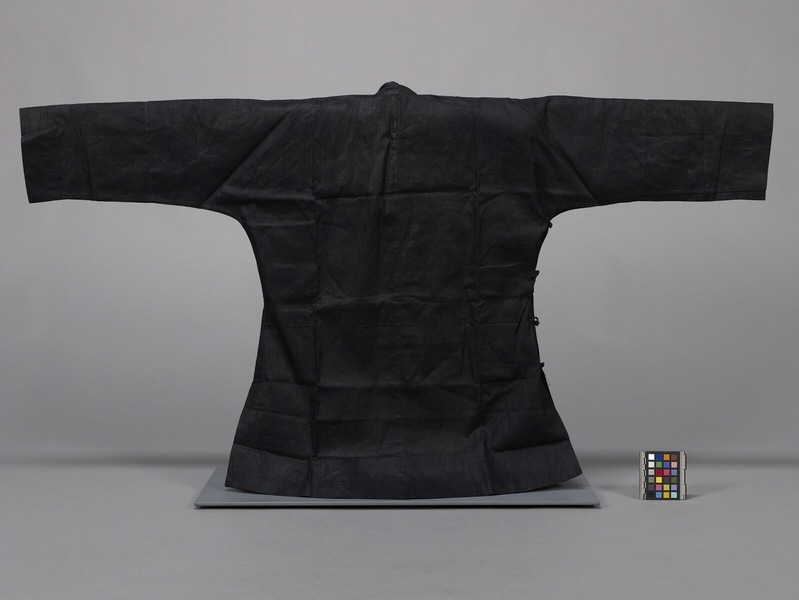Blouse Item Number: Edz932 from the MOA: University of British Columbia


Description
Black glazed cotton blouse with short standing collar, side slits and side opening with frog closures. The sleeves are one piece with the body. The bottom hem curves up at the sides. There is a pocket on the right inner flap. The inside is unlined.
History Of Use
Worn as upper garment. At this time women worn only dark colours or black. Cut of garment, its length and wide sleeve hems show that is several decades old. Wide neck facing shows it was to be worn while working (collector). Hakka women were known for their ability to do heavy labouring work outdoors. Their clothing in general was plain, decorated only with the hand-woven bands worn on their aprons, head cloths, and hats. After the mid-twentieth century the New Territories of Hong Kong began to undergo fundamental changes. The people who had been settled there before 1898, when the British colonizers claimed the area, began to give up rice agriculture and coastal fishing, turning instead to wage labour and increased employment overseas. By the end of the century, educational opportunities leading to the possibility of white-collar work also increased, together with western influences. These changes meant that objects and clothing once useful and appropriate were no longer needed and generally were discarded. Some were saved by their owners, who sometimes were willing to donate them to museums, sharing, also, their knowledge of how they were made and used. By the late 1960s, women were giving up traditional Chinese-style clothing in favour of western-influenced blouses and pants. Chinese-style clothing was custom made to fit by local tailors at this time (c. 1933). Young women went to them in groups to prevent them from taking liberties with them when they measured them. They wore tunics with matching pants, although hemp was used only for tunics because it was not comfortable for pants. New clothing was very special and usually made only before Chinese New Year. Women sometimes were unwilling to wear new clothes because they wanted to preserve them, and they remained in their dowry chests.
Narrative
Mrs. Yau was nineteen years old when this tunic was made for her. It is apparent that it was not worn and remained in her dowry chest , as indicated by the deep creases resulting from its being folded. Hakka people are one of the two original land-dwelling groups that settled the area that became the New Territories of Hong Kong. Their spoken language, and some customs, differed from those of the other original group, the Cantonese or Punti. The Cantonese arrived first and settled on the best rice-growing lands, while the Hakka began to arrive after the late 17th century and settled the more hilly lands.
Cultural Context
worn by women during the summer
Item History
- Made in Tsuen Wan, Hong Kong, China during 1933
- Collected during 1976
- Owned by Yau Chan Sek-Ying
- Owned by Elizabeth L. Johnson before September 2, 1976
- Received from Elizabeth L. Johnson (Donor) on September 2, 1976
What
- Name
- Blouse
- Identification Number
- Edz932
- Type of Item
- blouse
- Material
- cotton fibre and glaze
- Manufacturing Technique
- cut and machine stitched
- Overall
- height 75.0 cm, width 127.0 cm
Who
- Culture
- Chinese: Hakka
- Previous Owner
- Yau Chan Sek-Ying and Elizabeth L. Johnson
- Received from
- Elizabeth L. Johnson (Donor)
Where
- Holding Institution
- MOA: University of British Columbia
- Made in
- Tsuen Wan, Hong Kong, China
When
- Creation Date
- during 1933
- Collection Date
- during 1976
- Ownership Date
- before September 2, 1976
- Acquisition Date
- on September 2, 1976
Other
- Item Classes
- textiles
- Condition
- good
- Accession Number
- 0328/0032